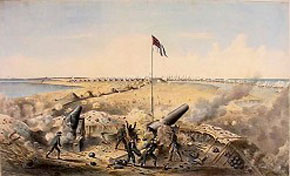Civil War Battles |
Colonial Wars |
American Wars |
Link To This Page — Contact Us —
The Battle of Fort Fisher
January 13-15, 1865 in Fort Fisher, North Carolina
 |
|||||||||||||||||||
|
The Christmas Day 1864 attack by a joint army-navy Union force on Fort Fisher, the Confederacy's earthwork bastion that protected the South's remaining major port of Wilmington, N.C., fizzled when Gen. Benjamin F. Butler lost his nerve, pulled out his troops, and returned to Hampton Roads, Va. To Adm. David D. Porter, the disgusted naval commander of the expedition who had prepared the way for Butler's assault with the greatest bombardment of the war, Union Gen. Ulysses S. Grant wrote that he would "be back again with an increased force and without the former commander."
The new commander was Gen. Alfred H. Terry, one of Butler's former division commanders, and the increased force was composed of 8,000 men in three white divisions and one black division. Located at the end of a long peninsula, Fort Fisher was a massive L-shaped earthwork that stretched 682 yards across the neck of land and another 1,898 yards down the beach. Armed with 44 heavy cannon to protect the approaches to the Cape Fear River and 125 other cannon to be used in its defense, and manned by 1,500 soldiers, the fort was a formidable target. Terry and Porter devised a plan of attack, and on January 13, 1865, under covering fire from Porter's 44 ships, Terry's men went ashore and established a beachhead five miles north of the fort. Terry set his black troops to work building and manning a strong line of works across the peninsula to hold off any Confederate threat to his rear. Terry scouted the land face of the fort and decided to make his attack there. To aid in the attack, Porter recruited 2,000 sailor and marine volunteers to storm the fort from the ocean side simultaneously with the army's assault.
Confederate Gen. W.H.C. Whiting, planner and builder of the fort, was unsuccessful in his efforts to get reinforcements and returned to Fort Fisher on the morning of the 13th. He greeted the fort's commander, Col. William Lamb, "Lamb, my boy, I have come to share your fate. You and your garrison are to be sacrificed."
"All day and night on the 13th and 14th of January, the navy continued it ceaseless torment. It was impossible to repair damages at night on the land-face, the Ironsides and monitors bowled their . . . shells along the parapet, scattering shrapnel in the darkness. We could scarcely gather up and bury our dead without fresh casualties," recorded Fort Fisher's Confederate commander Col. William Lamb. In the Union's second attempt to capture the coastal fort protecting Wilmington, N.C., the South's last major port available to blockade runners, a 44 ship flotilla pounded away at the fort, preparing the way for an assault by Union infantry, sailors, and marines.
At 2:30 P.M. on January 15, 1865, the great ship-borne guns suddenly fell silent, signaling the Union soldiers to attack. The Rebels rushed to defend the parapets with rifles and whatever artillery was still serviceable. The Yankee sailors and marines were repulsed in their attack on the fort's northeast face, but on the other end of the land face, Union troops gained a footing and progressed from one gun emplacement to another in vicious hand-to-hand fighting. Gen. W.H.C. Whiting, who had spent almost two years planning and building the great fort and had come back to share its fate, was mortally wounded.
One by one, each traverse on the land face fell to the attackers, and the outnumbered defenders falling back and regrouping to contest every inch. Colonel Lamb fought valiantly to save his fort. He even gathered together wounded men and led them back into the fray, only to be severely wounded himself. Once the northern wall of the fort had fallen, the rest of the bastion, the 1,898 yard sea face, was doomed. But the stubborn Rebels continued the struggle down the beach, finally surrendering at 10:00 that night.
The 10,000 Union attackers suffered 1,338 casualties. The 1,500 Rebels lost about 500 killed and wounded, with the rest captured.
Fascinating Fact: That night a company of New York soldiers slept on a grassy spot that was also the roof of the fort's main powder magazine. A pair of drunken sailors with torches stumbled into the magazine at dawn, touching off an explosion that killed or wounded another 104 Yanks.
